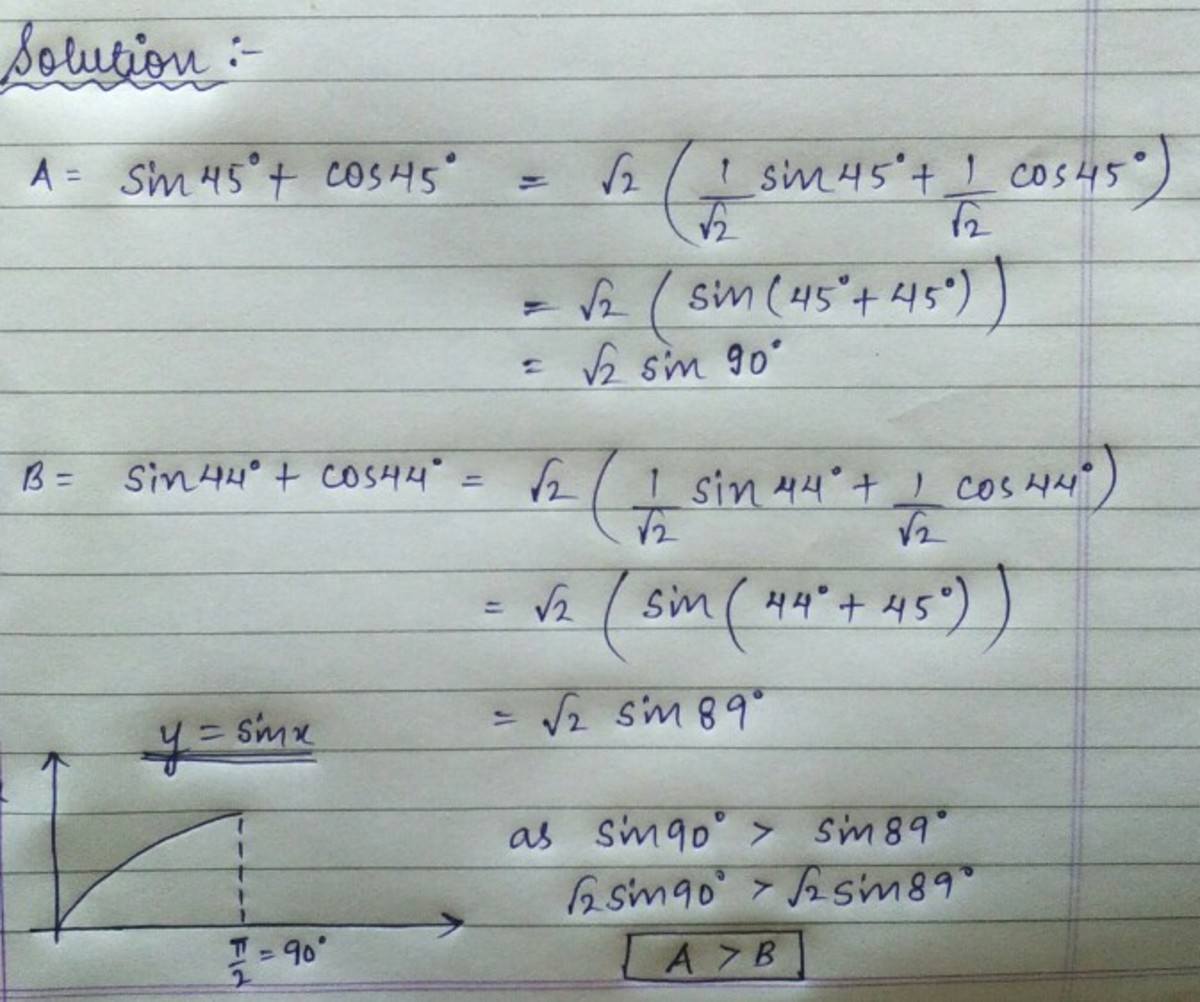Trigonometry Crush 5
If A = sin ( 4 5 ∘ ) + cos ( 4 5 ∘ ) and B = sin ( 4 4 ∘ ) + cos ( 4 4 ∘ ) , then which of the following statement is true?
This section requires Javascript.
You are seeing this because something didn't load right. We suggest you, (a) try
refreshing the page, (b) enabling javascript if it is disabled on your browser and,
finally, (c)
loading the
non-javascript version of this page
. We're sorry about the hassle.
4 solutions

Really elegant method!
Or you can show that for 0 ∘ < x < 9 0 ∘ , y = sin ( x ) + cos ( x ) = 1 + sin ( 2 x ) achieve its maximum point at sin ( 2 x ) = 1 ⇒ x = 4 5 ∘ . So A > B . But this works too YAY!
A B = sin 4 5 ∘ + cos 4 5 ∘ = 2 1 + 2 1 = 2 = sin 4 4 ∘ + cos 4 4 ∘ = sin ( 4 5 − 1 ) ∘ + cos ( 4 5 − 1 ) ∘ = sin 4 5 ∘ cos 1 ∘ − cos 4 5 ∘ sin 1 ∘ + cos 4 5 ∘ cos 1 ∘ + sin 4 5 ∘ sin 1 ∘ = 2 1 cos 1 ∘ − 2 1 sin 1 ∘ + 2 1 cos 1 ∘ + 2 1 sin 1 ∘ = 2 cos 1 ∘ < 2 = A [ cos 1 ∘ < 1 ]
Therefore, A > B .
Let us consider SinA + CosA.
The maximum value of this expression can be found by differentiation.
f'(x) = cosA-sinA = 0 gives the maxima .
that implies that sinA=cosA which occurs at 2 n π + α .(where n is an integer and alpha is equal to 45 degrees).
So, the principal solution(alpha) is 45 degrees.
So, SinA + CosA is maximum at 45 degrees.
To know for sure that this is the maxima, differentiate the function twice.
We get,
f''(x) = -sinA-cosA = negative at 45 degrees implies at 45 degrees, it is maxima.
So, Sin44+Cos44 < Sin45+Cos45.
Please correct me if I am wrong.
you are correct :) :) but in place of alpha there should be (pi/4) ... 4th line i hope you got it :)
Log in to reply
Yes I meant that the general solution is 2npi + alpha and here, alpha is the principal solution = pi/4.
Log in to reply
correct :)
i saw your edited solution now. That time i thought you have just accepted that fault . Anyways nice @Nelson Mandela upvoted :)
Log in to reply
@Raj Rajput – Thanks @Raj Rajput .
sin45+cos45 ? sin44+cos44
sin45-cos44 ? sin44-cos45
2 sin(1/2) cos(89/2) ? 2sin(-1/2) cos(89/2) sin(1/2) ? sin(-1/2) , as (2 cos(89/2) > 0)
sin(1/2) > sin(-1/2) A>B
Andrey Bessonov second step (there is no formula for sinc-cosd) is wrong , after correcting it too you will be having cos on one side and sin on other; so problem continues ....